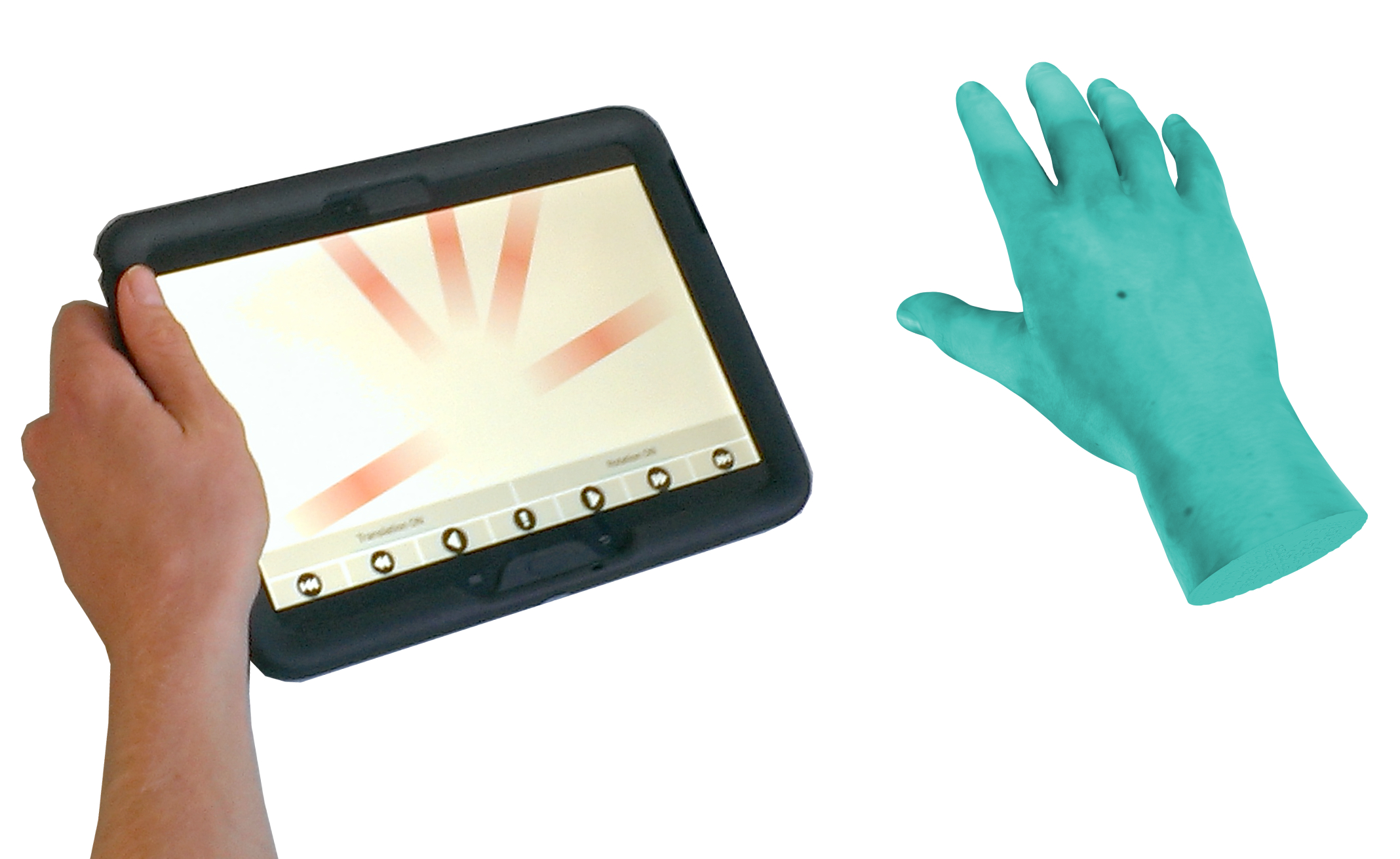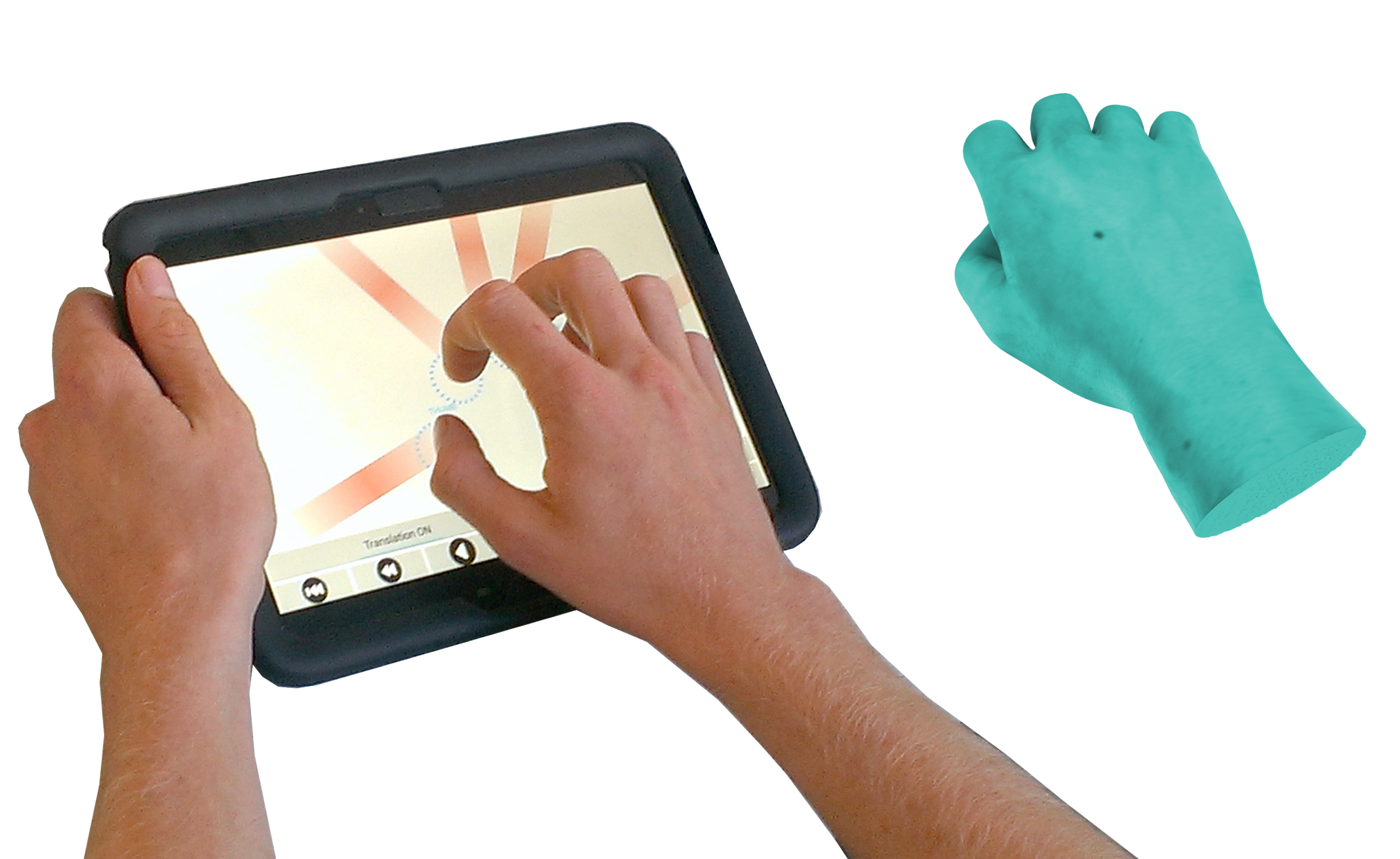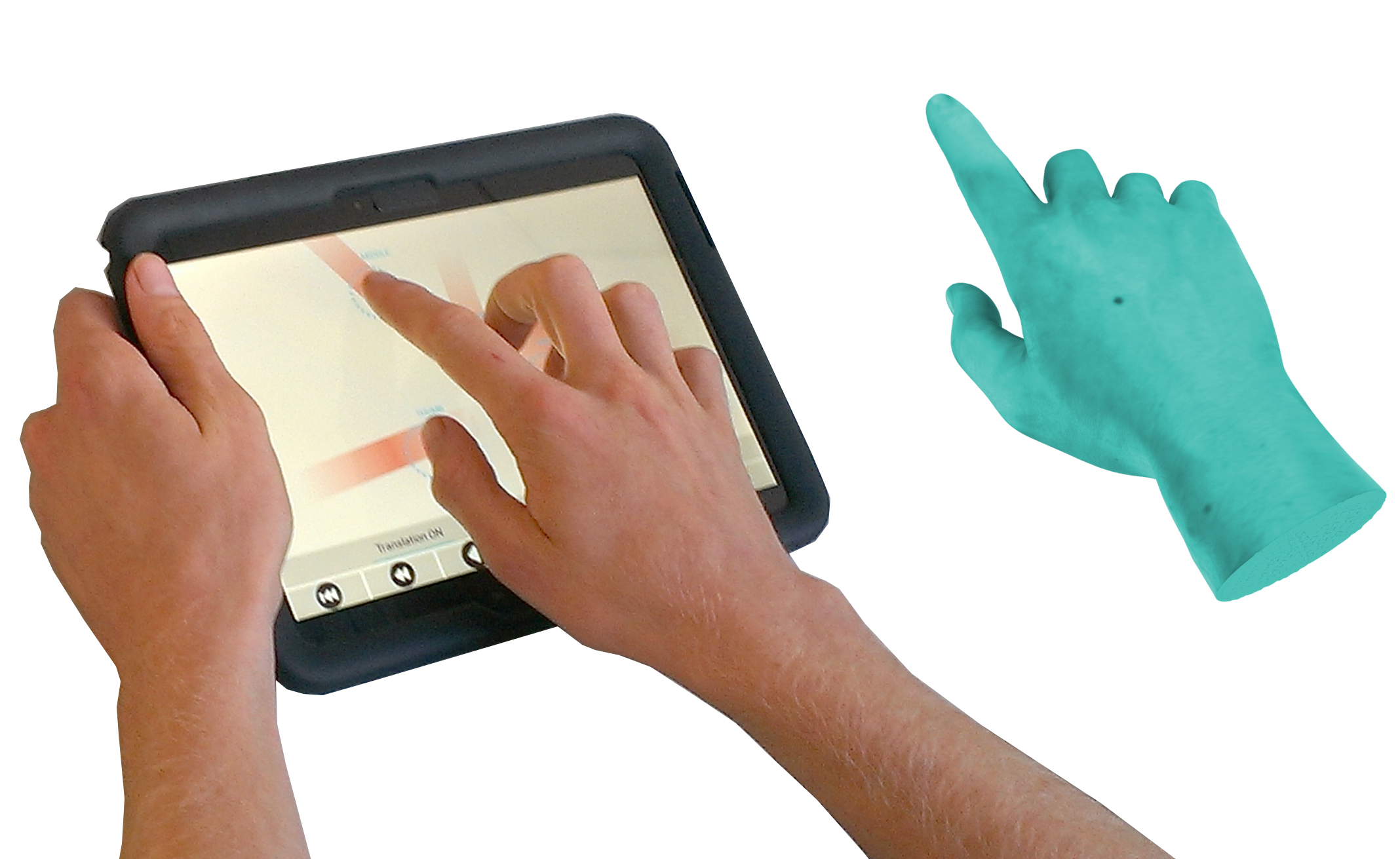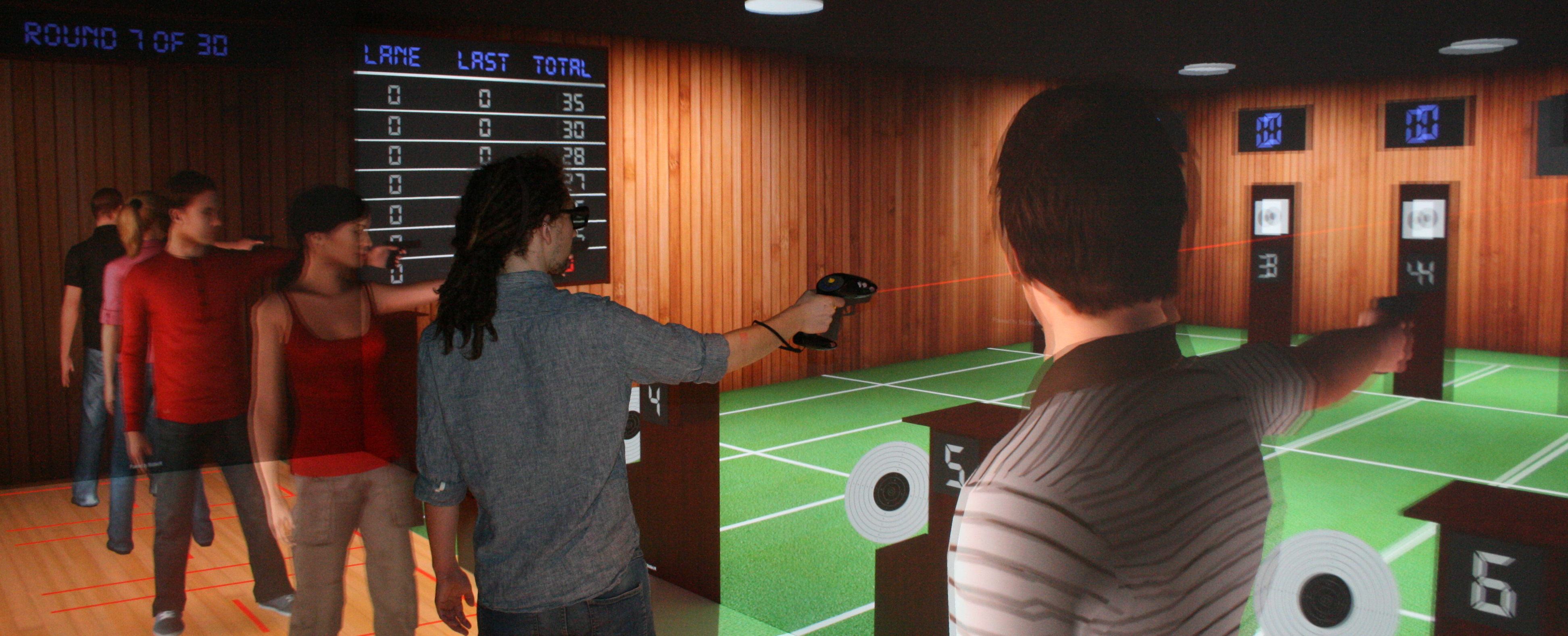Section: New Results
3D User Interfaces
Novel 3D Interactive Techniques
THING: Introducing a Tablet-based Interaction Technique for Controlling 3D Hand Models Merwan Achibet, Anatole Lécuyer and Maud Marchal
The hands of virtual characters are highly complex 3D models that can be tedious and time-consuming to animate with current methods. We introduced the THING [17] , a novel tablet-based approach that leverages multi-touch interaction for a quick and precise control of a 3D hand's pose 2 . The flexion/extension and abduction/adduction of the virtual fingers can be controlled for each finger individually or for several fingers in parallel through sliding motions on the surface of the tablet. We designed two variants of THING: (1) MobileTHING, which maps the spatial location and orientation of the tablet to that of the virtual hand, and (2) DesktopTHING, which combines multi-touch controls of fingers with traditional mouse controls for the global position and orientation of the hand model. We compared the usability of THING against mouse-only controls and a data glove in two controlled experiments. Results show that DesktopTHING was significantly preferred by users while providing performance similar to data gloves. Together, these results could pave the way to the introduction of novel hybrid user interfaces based on tablets and computer mice in future animation pipelines. This work was done in collaboration with Géry Casiez (Inria team MJOLNIR).
|
Plasticity for 3D User Interfaces: New Models for Devices and Interaction Techniques Jérémy Lachoche and Bruno Arnaldi
We have introduced new models for device and interaction techniques to overcome plasticity limitations in Virtual Reality (VR) and Augmented Reality (AR) [26] . We aimed to provide developers with solutions to use and create interaction techniques that fit to the 3D application tasks and to the input and output devices available. The device model describes input and output devices and includes capabilities, limitations and representations in the real world. We also propose a new way to develop interaction techniques with an approach based on PAC and ARCH models [43] . These techniques are implemented independently from the specific devices used thanks to the proposed device model. Moreover, our approach aims to facilitate the portability of interaction techniques over different target OS and 3D frameworks. This work was done in collaboration with Thierry Duval (Lab-STICC), Éric Maisel (ENIB) and Jérome Royan (IRT B-Com).
Dealing with Frame Cancellation for Stereoscopic Displays in 3D User Interfaces Jérémy Lacoche, Morgan Le Chénéchal, Valérie Gouranton and Bruno Arnaldi
We explored new methods to reduce ocular discomfort when interacting with stereoscopic content, focusing on frame cancellation [27] . Frame cancellation appears when a virtual object in negative parallax (front of the screen) is clipped by the screen edges; stereopsis cue lets observers perceive the object popping-out from the screen while occlusion cue provides observers with an opposite signal. Such a situation is not possible in the real world. This explains some visual discomfort for observers and leads to a poor depth perception of the virtual scene. This issue is directly linked to the physical limitations of the display size that may not cover the entire field of view of the observer. To deal with these physical constraints we introduce two new methods in the context of interactive applications. The first method consists in two new rendering effects based on progressive transparency that aim to preserve the popping-out effect of the stereo. The second method focuses on adapting the interaction of the user, not allowing him to place virtual objects in an area subject to frame cancellation. This work was done in collaboration with Sébastien Chalmé (IRT B-Com), Thierry Duval (Lab-STICC) and Éric Maisel (ENIB).
Understanding Human Perception in VR
Distance Estimation in Large Immersive Projection Systems, Revisited Ferran Argelaguet and Anatole Lécuyer
When walking within an immersive projection environment, accommodation distance, parallax and angular resolution vary according to the distance between the user and the projection walls which can influence spatial perception. As CAVE-like virtual environments get bigger, accurate spatial perception within the projection setup becomes increasingly important for application domains that require the user to be able to naturally explore a virtual environment by moving through the physical interaction space. In this work we performed two experiments which analyze how distance estimation is biased when accommodation distance, parallax and angular resolution vary [23] . The experiments were conducted in a large immersive projection setup with up to ten meter interaction range. The results showed that both accommodation distance and parallax have a strong asymmetric effect on distance judgments. We found an increased distance underestimation for positive parallax conditions as the accommodation-convergence difference increased. In contrast, we found less distance overestimation for negative and zero parallax conditions. Our findings also showed that angular resolution has a negligible effect on distance estimation. This work was done in collaboration with Anne-Hélène Olivier (MIMETIC) and Gerd Bruder (University of Hamburg).
Virtual Proxemics: Locomotion in the Presence of Obstacles in Large Immersive Projection Environments Ferran Argelaguet, Anatole Lécuyer
In the real world we navigate with ease by walking in the presence of obstacles, we develop avoidance strategies and behaviors which govern the way we locomote in the proximity of physical objects and other persons during everyday tasks. With the advances of virtual reality technology, it becomes important to gain an understanding of how these behaviors are affected in a virtual reality application. In this work, we analyzed the walking and collision avoidance behavior when avoiding real and virtual static obstacles [19] . In order to generalize our study, we considered both anthropomorphic and inanimate objects, each having his virtual and real counterpart. The results showed that users exhibit different locomotion behaviors in the presence of real and virtual obstacles, and in the presence of anthropomorphic and inanimate objects. Precisely, the results showed a decrease of walking speed as well as an increase of the clearance distance (i. e., the minimal distance between the walker and the obstacle) when facing virtual obstacles compared to real ones. Moreover, our results suggest that users act differently due to their perception of the obstacle: users keep more distance when the obstacle is anthropomorphic compared to an inanimate object and when the orientation of anthropomorphic obstacle is from the profile compared to a front position. We discussed implications on future large shared immersive projection spaces. This work was done in collaboration with Anne-Hélène Olivier (MIMETIC), Julien Pettré (MIMETIC) and Gerd Bruder (University of Hamburg).
Sports and Virtual Reality
A Methodology for Introducing Competitive Anxiety and Pressure in VR Sports Training Ferran Argelaguet and Anatole Lécuyer
Athletes' performance is influenced by internal and external factors, including their psychological state and environmental factors, especially during competition. As a consequence, current training programs include stress management. In this work, we explored whether highly immersive systems can be used for such training programs [11] . First, we proposed methodological guidelines to design sport training scenarios both on considering the elements that a training routine must have, and how external factors might influence the participant. The proposed guidelines are based on flow and social-evaluative threat theories. Second, to illustrate and validate our methodology, we designed an experiment reproducing a 10m Olympic pistol shooting competition 3 . We analyzed whether changes in the environment are able to induce changes in user performance, physiological responses and the subjective perception of the task. The simulation included stressors in order to raise a social-evaluative threat, such as aggressive public behavior or unforced errors, increasing the pressure while performing the task. The results showed significant differences in the user behavior and in their subjective impressions, trends in the physiological data were also observed. Taken together our results suggest that highly immersive systems could be further used for training systems in sports. This work was done in collaboration with Frank Multon (MIMETIC).
|
Experiencing the Past in Virtual Reality
An Immersive Virtual Sailing on the 18 th -Century Ship Le Boullongne Jean-Baptiste Barreau, Florian Nouviale and Valérie Gouranton
This work is the result of the collaboration between historians and computer scientists whose goal was the digital reconstitution of “Le Boullongne”, an 18th-century merchant ship of “La Compagnie des Indes orientale” [12] . This ship has now disappeared and its reconstitution aims at understanding on-board living conditions. Three distinct research laboratories have participated in this project so far. The first, a department of naval history, worked on historical documents, especially the logbooks describing all traveling events of the ship. The second, a research laboratory in archeology, archaeoscience and history, proposed a 3D model of the ship based on the original naval architectural plans. The third, a computer science research laboratory, implemented a simulation of the ship sailing in virtual reality. This work focuses on the reconstitution of the ship in virtual reality, aiming at restoring a realistic interactive naval simulation: the 3D model of the ship has been integrated in an ocean simulation, with a physical rendering of the buoyancy. The simulation allows a user to walk around on the ship, at a scale of 1:1, and even steer it through a natural interaction. Several characteristics of the simulation reinforce the sensation of being on-board: (1) A sonic environment mixing spatialized sounds (gulls flying, a whale swimming, wood cracking, cannons firing) and global soundscape (ocean and wind). (2) The meteorology of the simulation is dynamically modifiable; the user can increase the swell height and speed. The global illumination and wind sound vary in accordance with these parameters. The buoyancy simulation entails realistic movements of the ship. (3) Several interactions are proposed allowing the user to steer the ship with his/her hand, walk around on the ship, fire the cannons, and modify the weather. (4) Three animated sailors accompany the user in his/her sailing experience. They are wearing realistic period costumes. The immersive simulation has allowed historians to embark on “Le Boullongne” and to better understand how life was organized on-board. It has also been presented at several public exhibitions, in CAVE-like structures and HMD. This work was done in collaboration with Ronan Gaugne (Univ. Rennes 1), Yann Bernard (CReAAH) and Sylviane Llinares (CERHIO, UBS Lorient).
|
Touching and interacting with inaccessible cultural heritage Valérie Gouranton and Bruno Arnaldi
Sense of touch provides a particular access to our environment, enabling a tangible relation with it. In the particular use case of cultural heritage, touching the past, apart from being a universal dream, can provide essential information to analyze, understand, or restore artifacts. However, archaeological objects cannot always offer a tangible access, either because they have been destroyed or too damaged, or because they are part of a larger assembly. In other cases, it is the context of use that has become inaccessible, as it is related to an extinct activity. In [15] we proposed a workflow based on a combination of computed tomography, 3D images, and 3D printing to provide concrete access to cultural heritage, and we illustrate this workflow in different contexts of inaccessibility. These technologies are already used in cultural heritage, but seldom combined, and mostly for exceptional artifacts. We proposed to combine these technologies in case studies corresponding to relevant archaeological situations.
This work was done in collaboration with Théophane Nicolas (INRAP), Ronan Gaugne (Univ. Rennes 1), Cédric Tavernier (Image ET) and Quentin Petit (CNRS).
3D reconstruction of the loyola sugar plantation and virtual reality applications Jean-Baptiste Barreau, Valérie Gouranton
Discovered in 1988, the Loyola sugar plantation, owned by the Jesuits in French Guiana, is a major plantation of colonial history and slavery. Ongoing archaeological excavations have uncovered the Jesuit’s house and the outbuildings usually associated with a plantation such as a chapel and its cemetery, a blacksmith shop, a pottery, the remains of the entire sugar production (a windmill, a boiler and a dryer), coffee and indigo warehouses etc. Based on our findings and our network with 3D graphic designers and researchers in virtual reality, a 3D restitution integrated within a virtual reality platform was initiated to develop a better understanding of the plantation and its surrounding landscape. A specific work on the interactive changes of sunlight and animal sounds aimed to reconstruct a coherent evolution during one day of the site's environment [21] .
This work was done in collaboration with Quentin Petit (CNRS),Yann Bernard (CReAAH), Reginald Auger (Laval University, Canada), Yannick Le Roux (Laval University, French Guiana) Ronan Gaugne (IMMERSIA), and Cédric Tavernier (Image ET).






